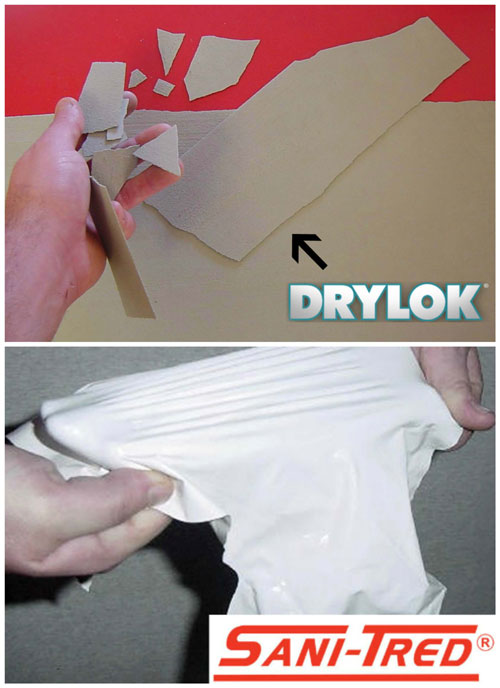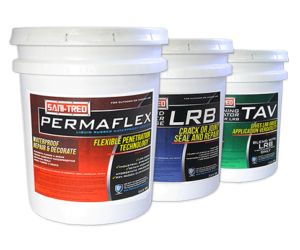 When looking for waterproofing solutions, you’ll notice a lot of options out there. Go down the aisles in any home improvement store and you’ll see all kinds of materials that claim to repair, protect, and even waterproof your concrete. But not all materials are made equal. While there are many options when you’re looking to waterproof your basement, none can stand up to SAIN-TRED.
When looking for waterproofing solutions, you’ll notice a lot of options out there. Go down the aisles in any home improvement store and you’ll see all kinds of materials that claim to repair, protect, and even waterproof your concrete. But not all materials are made equal. While there are many options when you’re looking to waterproof your basement, none can stand up to SAIN-TRED.
One popular material on the market is Drylok, a cementitious product that offers either a latex or oil-based option. Drylok is a combination of cement and paint used by many to protect and waterproof their basements. This is problematic when used to waterproof basements because the composition of Drylok basement paint means it doesn’t have adequate waterproofing abilities. Drylok is made of cement and latex or oil-based paint, materials that will not bond to cement, which is needed to waterproof a concrete surface.
Sani-Tred is a specially-formulated liquid rubber membrane that deeply penetrates the concrete surface and bonds with the concrete, protecting it and keeping the concrete waterproof.
See a description of the qualities of SANI-TRED that set it apart from other products
Versatility
Another major limitation of Drylok and similar products is the type of surfaces it can’t be applied to. The fact is Drylok is not intended for use on floors. However, if you’re planning on waterproofing your basement, you need to waterproof the walls AND the floor. Waterproofing one and not the other won’t result in a waterproofed basement.
Sani-Tred works on walls, floors, virtually any surface you need to waterproof. In addition to its superior adhesive properties, Sani-Tred offers versatility unmatched by other waterproof or cementitious materials. No other repair or cement waterproofing paint can match the versatility of Sani-Tred.
See the cost comparison of SANI-TRED versus other waterproofing methods
Coverage
For rough, porous concrete, Drylok recommends you apply at 75 sq. ft. per gallon for the first coat and up to 125 sq. ft. per gallon for each successive coat. On dense, smooth surfaces, you can apply at a rate of 100-125 sq. ft. per gallon for the first coat, with successive coats remaining the same. This can be a problem on larger projects. A larger space like a 1,000 sq. ft. basement would require more than 10 gallons of Drylok (and remember it won’t work on the floor). This doesn’t even cover what is needed to fix cracks and joints. That can get costly really quick, but more on that later.
Sani-Tred offers 240 sq. ft. per gallon on virtually any surface, with more porous surfaces requiring more than one priming coat. Any concrete surface can be fully coated and waterproofed using the same application process, with rough surfaces merely requiring an extra priming coat. With 240 sq. ft. per gallon of coverage, Sani-Tred can waterproof larger surfaces using less material and lowering your costs. Not only does Sani-Tred actually waterproof your basement, it has better coverage for less money in the long run.
Cost
Drylok appears to be the more economical choice. When you compare prices per gallon, Drylok is obviously much cheaper than Sani-Tred. If you’re in a home improvement store and see a cementitious coating for under $25, it appears to be a good deal. The problem with Drylok is not price, it’s performance. As we’ve established (and Drylok admits), Drylok isn’t really a waterproofing material, it doesn’t adhere to concrete, it doesn’t block out moisture, and still requires more material to cover less space. The end result is a cement paint that doesn’t waterproof your basement at all and only works on the walls. Why spend $25 on something that doesn’t work?
Sani-Tred costs more per bucket, but the advantage is that Sani-Tred is permanent. Once applied to a surface, the Sani-Tred system penetrates deep into the pores, adheres to the concrete, hardens while still maintaining flexibility, and waterproofs the concrete permanently. For a higher initial cost, you’re guaranteed a waterproof basement for the life of the structure.
It comes down to your options of a cement paint that doesn’t waterproof, doesn’t work on floors, but costs a little less and a specially-formulated rubber membrane that adheres to concrete, protects against freeze-thaw cycles, and permanently waterproofs your basement. The choice is clear.
Warranty
If all of this wasn’t enough, then there’s the warranty. Drylok offers a 15 year warranty on their coating, assuming you use it for its specific purpose (NOT waterproofing) and everything works out just right.
Sani-Tred offers a LIFETIME WARRANTY on its products because we know Sani-Tred will waterproof your entire basement permanently and protect it from water and negative hydrostatic pressure. We wouldn’t offer this warranty if we weren’t sure that Sani-Tred will effectively waterproof your basement.
When you’re looking to waterproof your basement, learn about your options to see which one is right for you. Just know that after you’ve looked at our competitors, you’ll find that Sani-Tred is the preeminent waterproofer on the market today. But don’t take our word for it, try SANI-TRED waterproofing products and see the difference for yourself.



i HAVE MULTI LAYERS OF DRY LOCK ON MY WALLS, CAN YOUR PRODUCT GO OVER THE EXISTING DRY LOCK OR DOES ALL OF THE PREVIOUS LAYERS DURING THE LAST 20 YEARS NEED TO COME OF AND HOW CAN YOU GET THIS MATERIAL OFF THE WALLS
We recommend removing all previous coatings before applying SANI-TRED. SANI-TRED offers “Off The Wall Coating Remover” (https://sanitred.com/off-the-wall-coating-remover/)
to assist in removing old Dry Lock paint
If a pressure washer cannot be utilized during this process, scraping or grinding with a hand grinder are acceptable removal methods. There is no real need to stress about removing paint that is “above grade” (no ground dirt on outside) towards the top of your basement wall, but as you move lower on the wall the removal of existing coatings is more critical for PermaFlex to be effective. Other tools like a “needle scaler” connected to an air compressor are effective methods for getting hard to reach areas and getting that old coating off.
Since the walls on part of the basement that I want to use this on were painted white at some point prior to me moving here 25 years ago. Is it necessary for me to remove all the paint, getting down to the bare block? That is a hell of a lot of work and even then there would be paint inside the block holes that you could not get out. I have some effervescing on the wall and some joints that need re-pointed, but no actual water coming through. Is using this waterproofing overkill and more work than needed?